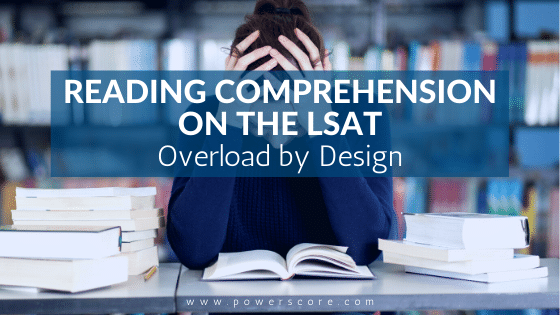The LSAT’s Reading Comprehension passages are typically dense and convoluted. Clearly, it’s not lazy summer beach reading. But what is the reason behind the design?
Reading vs. Reading Comprehension
When we read a passage, we’re performing several mental processes all at once. For example, as we read a sentence, we identify individual words and combine them into phrases and sentences. An experienced and skilled reader, such as a law school applicant, typically can recognize these words and obtain the explicit meaning of the text without allocating significant mental resources to the task. This makes it essentially an automated function.
However, to fully comprehend what we read requires greater skill and a greater allocation of our limited mental resources. We make inferences that tie the pieces of text together, integrating data such as entities, dates, events and conditions. We hold this information in our short term memory. To this we add our broader experience and knowledge, drawn from our long term memory. The addition of this material helps us pull deeper and broader meanings from the text. However, all of this work is resource intensive.
Intentional Clutter
When Reading Comprehension passages are cluttered with definitions, dueling viewpoints, and difficult syntax, LSAC essentially has sabotaged the otherwise automated tasks of recognizing vocabulary and extracting the explicit meaning of the text. This clutter isn’t the product of poor editing. To the contrary, it’s thoughtfully placed logic debris designed to increase your mental workload. It’s a series of cognitive obstructions you must consciously maneuver around to arrive safely at your destination. Plus, it has to be done within an aggressively limited time.
This concept of increased mental workload, and the effect of overload on performance, is not new. Nor is it isolated to the LSAT. One real-world example of this concept is the problem of distracted driving. Driving down a well-maintained, straight road in sunny weather when you’re the only car in sight is a low resource task. In that scenario, you may have the spare mental capacity to answer a phone call, mess with your radio and check the map all at the same time.
However, if you convert the road into a curving, mountain ascent in a snowstorm, with black ice forming on the pavement and crosswinds buffeting your car; simply driving in these conditions is no longer an automated, or even low resource task. Now, just surviving the trip is a high resource challenge. You no longer have the spare mental capacity to divide your attention with similar mental activities requiring the same perceptive and analytical functions. So, in this later case, the same act of taking that call or checking the map can send you into mental overload and off the cliff.
How to Stay Engaged
While the Reading Comprehension section certainly is not a treacherous mountain road, LSAC has designed its passages to be such high resource tasks that many students are pushed into overload. When that happens, they begin to feel overwhelmed, start to shut down by no longer actively engaging with the text, and start to make unforced, silly errors.
At PowerScore, we have long recognized this problem of mental overload in Reading Comprehension. The 7 Critical Steps of our Reading Comprehension approach will help you allocate your resources efficiently on test day. Our approach can help you pick through the clutter, organize the passage content in a way that is helpful and immediately accessible, and then attack the questions with confidence. While we can’t reduce the complexity of the passages you’ll see on test day, with our techniques you can efficiently distribute the load.


Leave a Reply